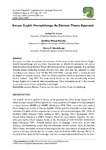Kenyan English Monophthongs: An Element Theory Approach
| dc.contributor.author | Itumo, Joshua M. | |
| dc.contributor.author | Maroko, Geoffrey M. | |
| dc.contributor.author | Nandelenga, Henry S. | |
| dc.date.accessioned | 2018-12-03T08:24:15Z | |
| dc.date.available | 2018-12-03T08:24:15Z | |
| dc.date.issued | 2017 | |
| dc.identifier.issn | 2376-760X | |
| dc.identifier.uri | http://ir.mksu.ac.ke/handle/123456780/2074 | |
| dc.description.abstract | This paper describes the acoustic characteristics of the non-ethnically marked Kenyan English (KenE) monophthongs and uses those characteristics to identify the phonemes and also to determine the internal Element Theory (ET) structure of the analysed segments. A purposively selected sample comprising fourteen lecturers was used. Oral data was obtained by audio recording as the subjects read ‘The Boy Who Cried Wolf’, a passage which is commonly used for English or acoustic analysis, which was done using Praat software. Quantitative data was further analysed using SPSS. The study mainly found out that the non-ethnically marked Kenyan English tends towards eight monophthongs. These monophthongs fall in five acoustic spaces and they are further isolated by vowel length. | en_US |
| dc.language.iso | en_US | en_US |
| dc.publisher | Journal of Applied Linguistics and Language Research | en_US |
| dc.subject | Acoustic | en_US |
| dc.subject | Element Theory | en_US |
| dc.subject | Monophthongs | en_US |
| dc.title | Kenyan English Monophthongs: An Element Theory Approach | en_US |
| dc.type | Article | en_US |

